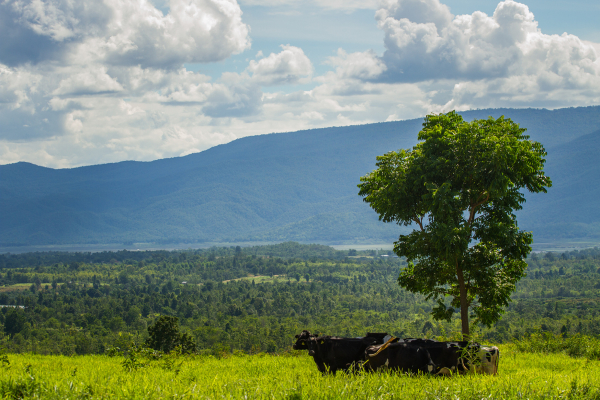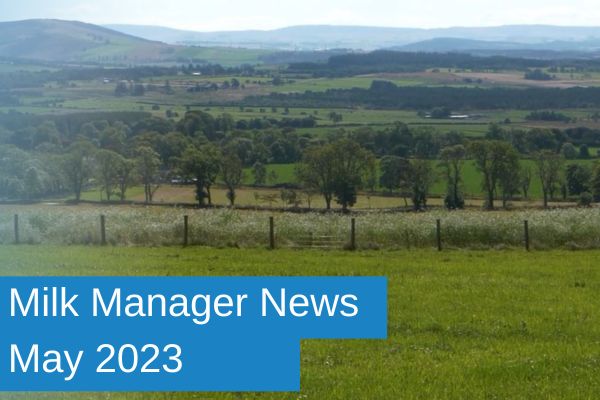Milk Manager News May 2023 – Get In On The Green
10 May 2023For a number of years now we have seen land prices driven to historic highs, pushed by incentives around tree planting and as a consequence, productive farms have been lost to the industry and new entrants have seen their opportunities to enter the sector shrink. You might therefore conclude that tree planting is a problem and that you want no part of it, but that is not the message you should take from this article. Instead, it should prompt the questions, “How can I normalise trees in the farmed landscape?” and “What is in it for me and my herd?”

For starters, Scottish Government have set targets for increased tree planting across the country and that target has only been going up in recent years, partly to tackle the issue of climate change and partly to create habitats and connectivity across the farmed landscape. This matters for the dairy sector, for one, while carbon footprints within the dairy sector tend to be lower per kg of output, emissions also tend to be high in comparison to beef and sheep units. Secondly, as Scottish Government pivot away from low carbon footprints to low emissions, it is in your benefit to soak up as much carbon as you can. For each hectare of land planted, a farm could expect to offset their emissions to the tune of 10,890kg CO2e per hectare (agrecalc, 2023) or 4kg per metre for those with hedges.
But move over climate change, because we also have a biodiversity crisis we are being asked to handle too, and in that regard, small scale tree planting can be an effective way of achieving high nature value for minimal cost, operating or otherwise. In December 2022 the Scottish Government published the first draft of their biodiversity strategy for 2045, outlining some fairly radical moves to link basic farm support to nature outcomes. I would encourage everyone to have even a brief look over it if you can as the direction of travel is clear, even if the fine details are not. Broadleaf is by and large the way to go for those looking to achieve a positive nature outcome. However, open grazed wood pasture offers tremendous opportunity for pollinators, farmland birds, small mammals and in the riparian environment, amphibians, and in the nature context is generally preferrable to commercial conifer woodland.
I mentioned riparian habitats earlier and I have spoken about the importance of the water environment and its links with the dairy sector before, but here is where trees really come into their own. As climate change happens and as summers in particular get hotter, water becomes scarcer and the average temperature of Scotland’s rivers increase. This can be a disaster for the water environment, with salmon and other fish species stressed and dying as a consequence of a few degrees increase. The water environment is also normally a good location for small scale tree planting as these areas tend to be less viable to improve, their layout can be fragmented and by providing tree cover and shade, you could help keep rivers hospitable.
But what about your cows? Well, in the same way trees provide shade and shelter for fish, they also do the same for larger grazing animals and we’ve all seen white cows with some bad sunburn. At the same time, provision of shelter can help cattle maintain more body condition and could be the difference between in and outwintering young cattle.
Dairy farms are also among the highest emitters of ammonia in the UK. Ammonia is emitted from dung and urine and ultimately breaks down into nitrous oxide, a highly toxic greenhouse gas. Trees have been identified as an effective mechanism for capturing ammonia relatively close to source and preventing it from entering the atmosphere or nearby watercourses. The last round of funding under the Sustainable Agriculture Capital Grant Scheme (SACGS) focused exclusively on supporting precision application of slurry, and planting some trees in conjunction with using a dribble bar or injector could be a way of compounding the benefits from multiple mitigation methods for maximum impact.
Lastly, “regenerative agriculture” is a term being thrown around a lot right now. For some it is a legitimate way for dairy farming to address concerns over sustainability and for others it might just be a tick box exercise, but there is no doubt that some of the principles of regenerative agriculture absolutely have a place on most, if not all farms. Concepts around keeping a living root, promoting the removal of carbon from the air deep into the soil and laying down valuable organic matter are all great ideas, whether you are genuinely enthusiastic or not.
alexander.pirie@sac.co.uk; 01292 525036
Sign up to the FAS newsletter
Receive updates on news, events and publications from Scotland’s Farm Advisory Service

